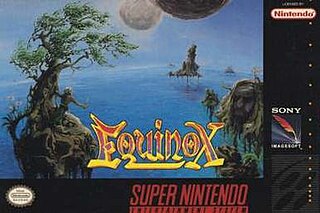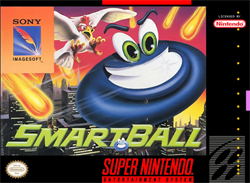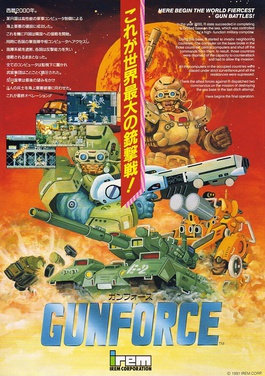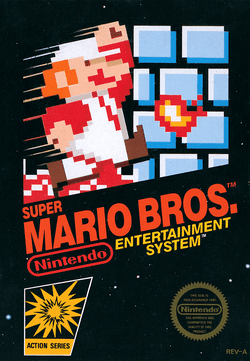
Asmik Ace, Inc., formerly Asmik Ace Entertainment, Inc. is a Japanese film production and distribution company. In the past, the company has distributed video games. It was formed in 1997 through a merger between the Asmik Corporation and Ace Entertainment, both of Japan. The name Asmik comes from its three founding companies: Ask, Sumitomo and Kodansha. The company is headquartered on the third floor of the Lapiross Roppongi building in Minato, Tokyo, and is a wholly owned division of Jupiter Telecommunications (J:COM).

Pilotwings is an amateur flight simulator video game developed and published by Nintendo for the Super Nintendo Entertainment System. The game was originally released in Japan in December 1990, shortly after the launch of the Super Famicom in the country. It was also released as a launch title for the SNES in August 1991 in North America, with a European release following in 1992.

Balloon Fight is an action video game developed by Nintendo and HAL Laboratory and published by Nintendo. The original arcade version was released for the Nintendo VS. System internationally as Vs. Balloon Fight, while its Nintendo Entertainment System counterpart was released in Japan in 1985 and internationally in 1986.

Xevious is a vertically scrolling shooter arcade video game developed and published by Namco in 1982. It was released in Japan by Namco and in North America by Atari, Inc. Controlling the Solvalou starship, the player attacks Xevious forces before they destroy all of mankind. The Solvalou has two weapons at its disposal: a zapper to destroy flying craft, and a blaster to bomb ground installations and enemies. It runs on the Namco Galaga arcade system.

Mode 7 is a graphics mode on the Super Nintendo Entertainment System video game console that allows a background layer to be rotated and scaled on a scanline-by-scanline basis to create many different depth effects. It also supports wrapping effects such as translation and reflection.

Recca is a 1992 scrolling shooter video game developed by KID and published by Naxat Soft for the Family Computer. Controlling the titular space fighter craft, the player is sent to counterattack an invading alien armada while avoiding collision with their projectiles and other obstacles. The ship has a powerful bomb at its disposal that can be used as shield and clear the screen of enemies and bullets when fully charged.

Equinox is an action adventure puzzle video game developed by Software Creations and published by Sony Imagesoft for the Super NES. A sequel to Solstice (1990) for the Nintendo Entertainment System, Equinox depicts Glendaal saving his father Shadax, the previous game's playable character, from the imprisonment of Sonia, Shadax's apprentice. The player acts as Glendaal, exploring 458 rooms in eight underground dungeons. The player collects 12 blue orb tokens while solving puzzles, killing enemies, collecting keys, navigating platforms and blocks, and battling bosses. It continues Solstice's isometric puzzle game style, with greater emphasis on action adventure and Mode 7 overworld map.

Axelay is a 1992 scrolling shooter video game developed and published by Konami for the Super Nintendo Entertainment System. Set in the fictional solar system Illis where an alien empire known as "Armada of Annihilation" invades its planets including the Earth-like Corliss (Mother), players take control of the titular D117B space fighter craft as a last resort to stop the alien invasion by recovering its lost weaponry. The gameplay mainly consist of both vertical-scrolling and horizonal-scrolling stages in the same vein as Konami's own Life Force, with players choosing three different weapon-types that increase in number as they progress through the game.

Star Force, also released in arcades outside of Japan as Mega Force, is a vertical-scrolling shooter computer game released in 1984 by Tehkan.

Bio Miracle Bokutte Upa is a Konami video game that was first released for a Japan-exclusive market in 1988 for the Family Computer Disk System. It was later released as a cartridge in 1993 for the Family Computer itself.

Super Ghouls 'n Ghosts, known as Chou Makaimura in Japan, is a platform video game developed and published by Capcom for the Super Nintendo Entertainment System in 1991. As the third game in the Ghosts 'n Goblins series and the first not to be released for the arcade, it again depicts knight Arthur saving Princess Guinevere and the kingdom from Emperor Sardius, who has cast a spell that has revived the Ghoul Realm.

HyperZone is a rail shooter video game developed and published by HAL Laboratory for the Super Nintendo Entertainment System (SNES). It used the SNES' Mode 7 capability.

BlaZeon is a horizontally scrolling shoot 'em up arcade game released by Atlus in 1992 and was ported to the Super Nintendo Entertainment System in the same year. The game's most distinguishable feature is that players come equipped with a device that allows them to freeze and control certain robots.
Star Soldier is a series of scrolling shooters mainly developed by Hudson Soft. Konami has owned the rights to the series since their absorption of Hudson Soft in 2012. The first game, named Star Soldier, appeared on the MSX and NES in 1986, and the series has continued on various gaming systems. Star Soldier itself has received enhanced remakes for both the GameCube and PlayStation 2 in 2003, and a different remake for the PlayStation Portable in 2005, while the latest installment of the series was released on the Wii as a WiiWare game in 2008. In addition, Super Star Soldier, Final Soldier, Soldier Blade and Star Parodier have been re-released on the Wii's Virtual Console and on the Japanese PC Engine's Best Collection lineup for the PSP. The Star Soldier games are best known for their distinctive music, unique weapon power-ups, and a special time attack high score mode called "Caravan Mode".

Burai Fighter is a shoot 'em up video game developed by KID for the Nintendo Entertainment System. The game was released in North America by Taxan in March 1990, PAL regions by Nintendo in 1990, and Japan by Taito on July 20, 1990. The game was ported to the Game Boy and retitled as Burai Fighter Deluxe, and was released in Japan on June 27, 1990, in North America in January 1991 and in Europe in 1991; this port was released for the Game Boy Color as Space Marauder, originally released in Japan as Burai Fighter Color, as the original Game Boy version is not compatible with the later models.

Smart Ball is a platform game developed by Game Freak and System Sacom. It was published by Epic/Sony Records and Sony Imagesoft for the Super Nintendo Entertainment System in 1991. A sequel titled Jerry Boy 2 was in production, but was not released.

Contra III: The Alien Wars is a 1992 run and gun video game developed and published by Konami for the Super Nintendo Entertainment System (SNES). It is the third home console entry in the Contra series after Contra (1988) and Super C (1990) for the Nintendo Entertainment System (NES). In PAL regions, it was retitled Super Probotector: Alien Rebels and the player characters were replaced with robots. The player is tasked with fighting off an alien invasion of Earth across six stages. Four stages feature side-scrolling action traditional to the series while two are presented from an overhead perspective. It is the first Contra title to have been directed by Nobuya Nakazato who later directed other games in the series. He designed Contra III to feature more comical elements, a more cinematic soundtrack, and tighter stage design than its predecessors.

GunForce is a side-scrolling run and gun video game produced by Irem for arcades in 1991. The game was ported by Bits Studios and published by Irem for the Super Nintendo Entertainment System in 1992. The sequel, GunForce II, was originally known in Japan as Geo Storm.

Super Mario Bros. is a platform game developed and published in 1985 by Nintendo for the Famicom in Japan and for the Nintendo Entertainment System (NES) in North America. It is the successor to the 1983 arcade game Mario Bros. and the first game in the Super Mario series. Following a US test market release for the NES, it was converted to international arcades on the Nintendo VS. System in early 1986. The NES version received a wide release in North America that year and in PAL regions in 1987.

Gradius III is a 1989 scrolling shooter video game developed and published by Konami, originally released for the arcades in Japan and other parts of Asia on December 11, 1989. It is the third game in the Gradius series. The game was ported to the Super Nintendo Entertainment System in Japan in 1990 and North America in 1991, and served as a launch title for the system in North America. The arcade version would never see the light of day in the West until it was included alongside Gradius IV in a two-in-one compilation for the PlayStation 2 and in the Gradius Collection for the PlayStation Portable.



















